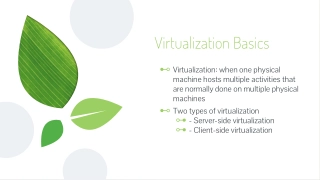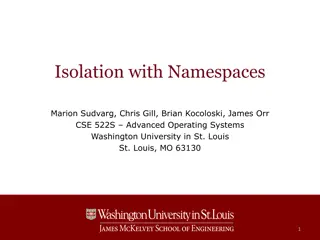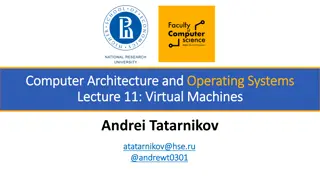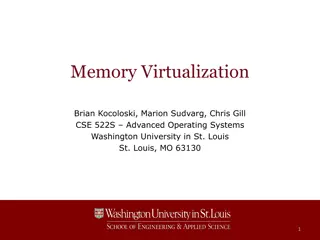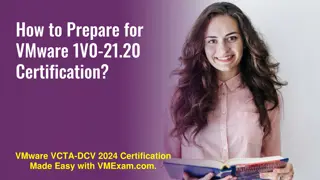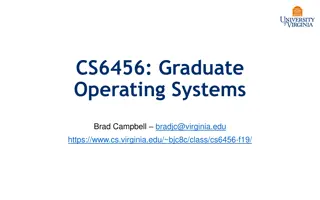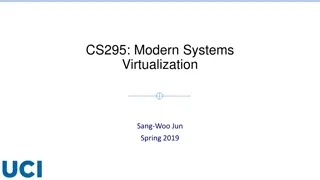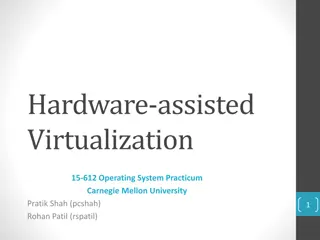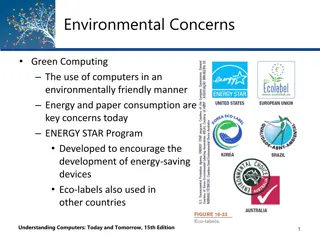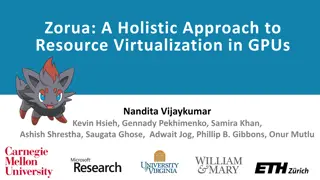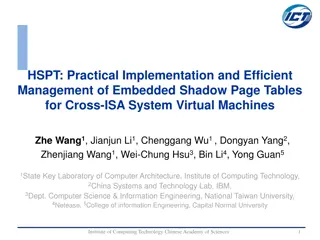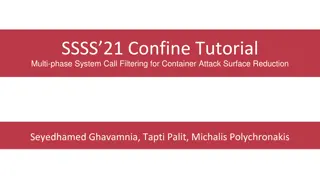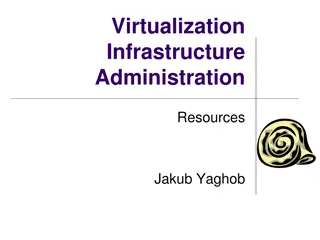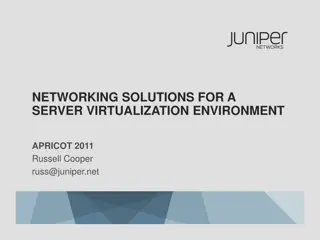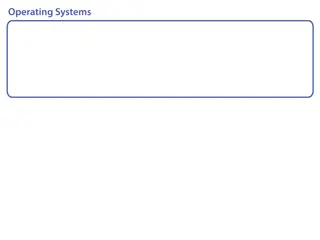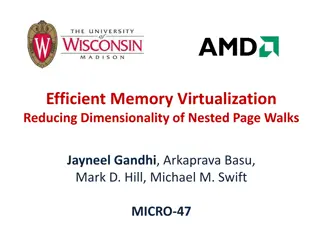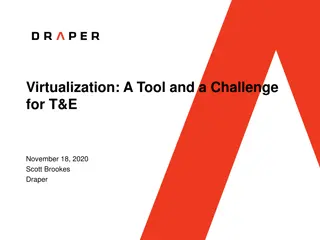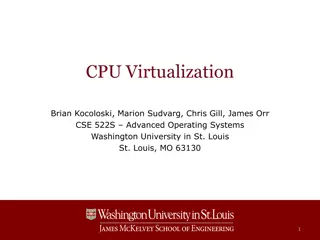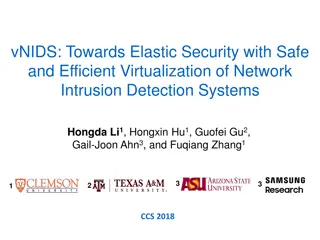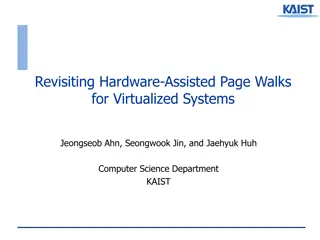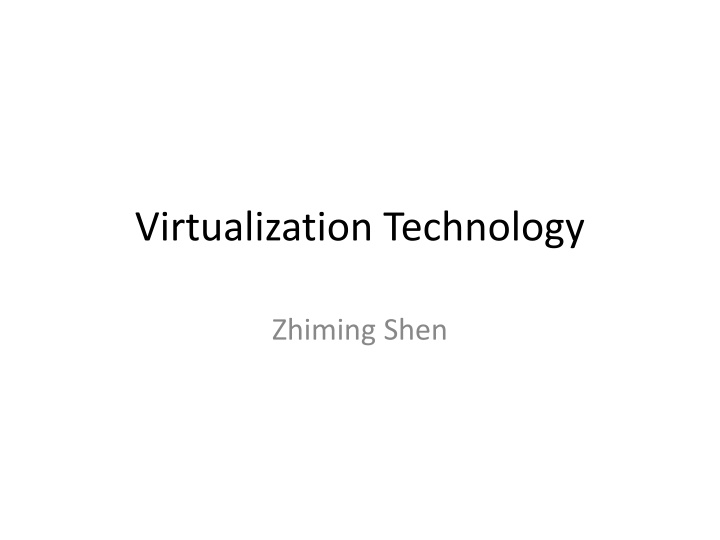
Evolution of Virtualization Technology: A Comprehensive Overview
Explore the evolution of virtualization technology from its inception in the 1960s with IBM VM/370 to modern solutions like dynamic binary translation on x86 architecture. Discover the challenges, solutions, and key developments in virtualization technology over the decades.
Download Presentation

Please find below an Image/Link to download the presentation.
The content on the website is provided AS IS for your information and personal use only. It may not be sold, licensed, or shared on other websites without obtaining consent from the author. If you encounter any issues during the download, it is possible that the publisher has removed the file from their server.
You are allowed to download the files provided on this website for personal or commercial use, subject to the condition that they are used lawfully. All files are the property of their respective owners.
The content on the website is provided AS IS for your information and personal use only. It may not be sold, licensed, or shared on other websites without obtaining consent from the author.
E N D
Presentation Transcript
Virtualization Technology Zhiming Shen
Virtualization: rejuvenation 1960 s: first track of virtualization Time and resource sharing on expensive mainframes IBM VM/370 Late 1970 s and early 1980 s: became unpopular Cheap hardware and multiprocessing OS Late 1990 s: became popular again Wide variety of OS and hardware configurations VMWare Since 2000: hot and important Cloud computing Docker containers
IBM VM/370 Robert Jay Creasy (1939-2005) Project leader of the first full virtualization hypervisor: IBM CP-40, a core component in the VM system The first VM system: VM/370
IBM VM/370 Specialized VM subsystem (RSCS, RACF, GCS) Conversatio nal Monitor System (CMS) Mainstream OS (MVS, DOS/VSE etc.) Another copy of VM Virtual machines Hypervisor Control Program (CP) System/370 Hardware
IBM VM/370 Technology: trap-and-emulate Problem Application Kernel Privileged Trap Emulate CP
Virtualization on x86 architecture Challenges Correctness: not all privileged instructions produce traps! Example: popf Performance: System calls: traps in both enter and exit (10X) I/O performance: high CPU overhead Virtual memory: no software-controlled TLB
Virtualization on x86 architecture Solutions: Dynamic binary translation & shadow page table Hardware extension Para-virtualization (Xen)
Dynamic binary translation Idea: intercept privileged instructions by changing the binary Cannot patch the guest kernel directly (would be visible to guests) Solution: make a copy, change it, and execute it from there Use a cache to improve the performance
Dynamic binary translation Pros: Make x86 virtualizable Can reduce traps Cons: Overhead Hard to improve system calls, I/O operations Hard to handle complex code
Shadow page table Guest page table Shadow page table
Shadow page table Pros: Transparent to guest VMs Good performance when working set is stable Cons: Big overhead of keeping two page tables consistent Introducing more issues: hidden fault, double paging
Hardware support First generation - processor Second generation - memory Third generation I/O device
First generation: Intel VT-x & AMD SVM Eliminating the need of binary translation Host mode Guest mode Ring3 Ring3 VMRUN Ring2 Ring2 Ring1 Ring1 VMEXIT Ring0 Ring0
Second generation: Intel EPT & AMD NPT Eliminating the need to shadow page table
Third generation: Intel VT-d & AMD IOMMU I/O device assignment VM owns real device DMA remapping Support address translation for DMA Interrupt remapping Routing device interrupt
Para-virtualization Full vs. para virtualization
Xen and the art of virtualization SOSP 03 Very high impact (data collected in 2013) Citation count in Google scholar 6000 5153 5000 4000 3000 2286 1796 2000 1413 1229 1222 1219 1093 1000 461 0 Disco (1997) A fast file system for UNIX (1984) SPIN (1995) Exokernel (1995) Coda (1990) Log-structured The UNIX time-sharing system (1974) End-to-end arguments in system design (1984) Xen(2003) file system (1992)
Overview of the Xen approach Support for unmodified application binaries (but not OS) Keep Application Binary Interface (ABI) Modify guest OS to be aware of virtualization Get around issues of x86 architecture Better performance Keep hypervisor as small as possible Device driver is in Dom0
Virtualization on x86 architecture Challenges Correctness: not all privileged instructions produce traps! Example: popf Performance: System calls: traps in both enter and exit (10X) I/O performance: high CPU overhead Virtual memory: no software-controlled TLB
CPU virtualization Protection Xen in ring0, guest kernel in ring1 Privileged instructions are replaced with hypercalls Exception and system calls Guest OS registers handles validated by Xen Allowing direct system call from app into guest OS Page fault: redirected by Xen
CPU virtualization (cont.) Interrupts: Lighweight event system Time: Interfaces for both real and virtual time
Memory virtualization Xen exists in a 64MB section at the top of every address space Guest sees real physical address Guest kernels are responsible for allocating and managing the hardware page tables. After registering the page table to Xen, all subsequent updates must be validated.
I/O virtualization Shared-memory, asynchronous buffer descriptor rings
Conclusion x86 architecture makes virtualization challenging Full virtualization unmodified guest OS; good isolation Performance issue (especially I/O) Para virtualization: Better performance (potentially) Need to update guest kernel Full and para virtualization will keep evolving together
Microkernel vs. VMM(Xen) Virtual Machine Monitor (VMM): software which transforms the single machine interface into the illusion of many. Each of these interfaces (virtual machines) is an efficient replica of the original computer system, complete with all of the processor instructions -- Robert P. Goldberg. Survey of virtual machine research. 1974 Microkernel: "... to minimize the kernel and to implement whatever possible outside of the kernel -- Jochen Liedtke. Towards real microkernels. 1996
Are Virtual Machine Monitors Microkernels Done Right? Steven Hand, Andrew Wareld, Keir Fraser HotOS 05 VMMs (especially Xen) are microkernels done right Avoid liability inversion: Microkernels depend on some user level components Make IPC performance irrelevant: IPC performance is the key in microkernels Treat the OS as a component Hard for microkernels to support legacy applications
Are Virtual Machine Monitors Microkernels Done Right? Gernot Heiser, Volkmar Uhlig, Joshua LeVasseur ACM SIGOPS 06 VMMs (especially Xen) are microkernels done right. Avoid liability inversion: Microkernels depend on some user level components Make IPC performance irrelevant: IPC performance is the key in microkernels Treat the OS as a component Hard for microkernels to support legacy applications Look at L4Linux! Really?? Xen also relies on Dom0! Xen performs the same number of IPC!
Discussion What is the difference between VMMs and microkernels? Why do VMMs seem to be more successful than microkernels?
Conclusion (again) Virtualization: creating a illusion of something Virtualization is a principle approach in system design OS is virtualizing CPU, memory, I/O VMM is virtualizing the whole architecture What else? What next?

